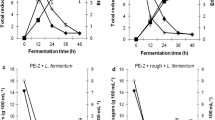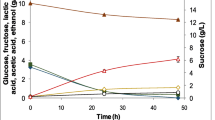Abstract
The alcoholic fermentation for fuel ethanol production in Brazil occurs in the presence of several microorganisms present with the starter strain of Saccharomyces cerevisiae in sugarcane musts. It is expected that a multitude of microbial interactions may exist and impact on the fermentation yield. The yeast Dekkera bruxellensis and the bacterium Lactobacillus fermentum are important and frequent contaminants of industrial processes, although reports on the effects of both microorganisms simultaneously in ethanolic fermentation are scarce. The aim of this work was to determine the effects and interactions of both contaminants on the ethanolic fermentation carried out by the industrial yeast S. cerevisiae PE-2 in two different feedstocks (sugarcane juice and molasses) by running multiple batch fermentations with the starter yeast in pure or co-cultures with D. bruxellensis and/or L. fermentum. The fermentations contaminated with D. bruxellensis or L. fermentum or both together resulted in a lower average yield of ethanol, but it was higher in molasses than that of sugarcane juice. The decrease in the CFU number of S. cerevisiae was verified only in co-cultures with both D. bruxellensis and L. fermentum concomitant with higher residual sucrose concentration, lower glycerol and organic acid production in spite of a high reduction in the medium pH in both feedstocks. The growth of D. bruxellensis was stimulated in the presence of L. fermentum resulting in a more pronounced effect on the fermentation parameters than the effects of contamination by each microorganism individually.




Similar content being viewed by others
References
Amorim HV, Lopes ML, Oliveira JVC, Buckeridge MS, Goldman GH (2011) Scientific challenges of bioethanol production in Brazil. Appl Microbiol Biotechnol 91:1267–1275
Andrietta MGS, Andrietta SR, Stupiello ENA (2011) Bioethanol—what has Brazil learned about yeasts inhabiting the ethanol production processes from sugar cane? In: Bernardes MAS (ed) Biofuel production—recent developments and prospects. InTech, Rijeka, pp 67–84
Barnett JA, Payne RW, Yarrow D (2000) Yeasts: characteristics and identification. Cambridge University Press, Cambridge
Bassi APG, Silva JCG, Reis VR, Ceccato-Antonini SR (2013) Effects of single and combined cell treatments based on low pH and high concentrations of ethanol on the growth and fermentation of Dekkera bruxellensis and Saccharomyces cerevisiae. World J Microbiol Biotechnol 29:1661–1676
Basso LC, Amorim HV, Oliveira AJ, Lopes ML (2008) Yeast selection for fuel ethanol production in Brazil. FEMS Yeast Res 8:1155–1163
Basso TO, Gomes FS, Lopes ML, Amorim HV, Eggleston G, Basso LC (2014) Homo- and heterofermentative lactobacilli differently affect sugarcane-based fuel ethanol fermentation. Antonie Van Leeuwenhoek 105:169–177
Blomqvist J (2011) Dekkera bruxellensis—a competitive yeast for ethanol production from conventional and non-conventional substrates. PhD Thesis, Swedish University of Agricultural Sciences
Bonatelli ML, Quecine MC, Silva MS, Labate CA (2017) Characterization of the contaminant bacterial communities in sugarcane first-generation industrial ethanol production. FEMS Microbiol Lett. https://doi.org/10.1093/femsle/fnx159
Burns TR, Osborne JP (2013) Impact of malolactic fermentation on the color and color stability of pinot noir and merlot wine. Am J Enol Vitic 64:370–377
Cardenas N, Laiño JE, Delgado S, Jiménez E, Del Valle MJ, de Giori GS, Sesma F, Mayo B, Fernández L, LeBlanc JG, Rodriguez JM (2015) Relationships between the genome and some phenotypical properties of Lactobacillus fermentum CECT 5716, a probiotic strain isolated from human milk. Appl Microbiol Biotechnol 99:4343–4353
Carvalho-Netto OV, Carazzolle MF, Mofatto LS, Teixeira PJPL, Noronha MF, Calderón LAL, Mieczkowski PA, Argueso JL, Pereira GAG (2015) Saccharomyces cerevisiae transcription reprogramming due to bacterial contamination during industrial scale bioethanol production. Microb Cell Fact 14:1–13
Cogan TM, Jordan KN (1994) Metabolism of Leuconostoc bacteria. J Dairy Sci 77:2704–2717
Conterno L, Fondazione E, Henick-Kling T (2010) Brettanomyces/Dekkera off-flavours and other wine faults associated with microbial spoilage. In: Reynolds AG (ed) Managing wine quality. Woodhead Publishing, Cambridge, pp 346–387
Costa MAS, Cerri BC, Ceccato-Antonini SR (2017) Ethanol addition enhances acid treatment to eliminate Lactobacillus fermentum from the fermentation process for fuel ethanol production. Lett Appl Microbiol. https://doi.org/10.1111/lam.12819
Curtin CD, Langhans G, Henschke PA, Grbin PR (2013) Impact of Australian Dekkera bruxellensis strains grown under oxygen-limited conditions on model wine composition and aroma. Food Microbiol 36:241–247
Duarte-Almeida JM, Salatino A, Genovese MI, Lajolo FM (2011) Phenolic composition and antioxidant activity of culms and sugarcane (Saccharum officinarum L.) products. Food Chem 125:660–664
Filannino P, Gobbetti M, de Angelis M, di Cagno R (2014) Hydroxycinnamic acids used as external acceptors of electrons: an energetic advantage for strictly heterofermentative lactic acid bacteria. Appl Environ Microbiol 80(24):7574–7582
Galafassi S, Capusoni C, Moktaduzzaman M, Compagno C (2013) Utilization of nitrate abolishes the ‘Custers effect’ in Dekkera bruxellensis and determines a different pattern of fermentation products. J Ind Microbiol Biotechnol 40:297–303
Heresztyn T (1986) Formation of substituted tetrahydropyridines by species of Brettanomyces and Lactobacillus isolated from mousy wines. Am J Enol Vitic 37:127–131
Hucker B, Christophersen M, Vriesekoop F (2017) The influence of thiamine and riboflavin on various spoilage microorganisms commonly found in beer. J Inst Brew 123:24–30
Jayashree S, Rajendhran J, Jayaraman K, Kalaichelvan G, Gunasekaran P (2011) Improvement of riboflavin production by Lactobacillus fermentum isolated from yogurt. Food Biotechnol 25:240–251
Kheir J, Salameh D, Strehaiano P, Brandam C, Lteif R (2013) Impact of volatile phenols and their precursors on wine quality and control measures of Brettanomyces/Dekkera yeasts. Eur Food Res Technol 237(5):655–671
Kosel J, Cadez N, Raspor P (2014) Factors affecting volatile phenol production during fermentations with pure and mixed cultures of Dekkera bruxellensis and Saccharomyces cerevisiae. Food Technol Biotechnol 52(1):35–45
LeBlanc JG, Lain JE, del Valle JM, Vannini V, van Sinderen D, Taranto MP, Font de Valdez G, Savoy de Giori G, Sesma F (2011) B-Group vitamin production by lactic acid bacteria—current knowledge and potential applications. J Appl Microbiol 111:1297–1309
LeBlanc JG, Chain F, Martin R, Bermudez-Humaran LG, Courau S, Langella P (2017) Beneficial effects on host energy metabolism of short-chain fatty acids and vitamins produced by commensal and probiotic bacteria. Microb Cell Fact 16:79–89
Lee SS, Robinson FM, Wang HY (1981) Rapid determination of yeast viability. Biotechnol Bioeng 11:641–649
Leite FCB, Basso TO, de Barros Pita W, Gombert AK, Simões DA, Morais MA Jr (2013) Quantitative aerobic physiology of the yeast Dekkera bruxellensis, a major contaminant in bioethanol production plants. FEMS Yeast Res 13:34–43
Lopes ML, Paulillo SCL, Godoy A, Cherubin RA, Lorenzi MS, Giometti FHC, Bernardino CD, Amorim Neto HB, Amorim HV (2016) Ethanol production in Brazil: a bridge between science and industry. Braz J Microbiol 47(1):64–76
Lucena BTL, dos Santos BM, Moreira JLS, Moreira APB, Nunes AC, Azevedo V, Miuoshi A, Thompson FL, Morais MA Jr (2010) Diversity of lactic acid bacteria of the bioethanol process. BMC Microbiol 10:298–305
Martín R, Olivares M, Marín ML, Xaus J, Fernández L, Rodríguez JM (2005) Characterization of a reuterin-producing Lactobacillus coryniformis strain isolated from a goat’s milk cheese. Int J Food Microbiol 104:267–277
Meneghin MC, Bassi APG, Codato CB, Reis VR, Ceccato-Antonini SR (2013) Fermentative and growth performances of Dekkera bruxellensis in different batch systems and the effect of initial low cell counts in co cultures with Saccharomyces cerevisiae. Yeast 30:295–305
Miller GL (1959) Use of dinitrosalicylic acid reagent for determination of reducing sugar. Anal Chem 31:426
Naczak M, Shahidi F (2006) Phenolics in cereals, fruits and vegetables: occurrence, extraction and analysis. J Pharm Biomed Anal 41(5):1523–1542
National Center for Biotechnology Information (2017) PubChem Compound Database, CID 31242. https://pubchem.ncbi.nlm.nih.gov/compound/31242. Accessed 19 Dec 2017
Passoth V, Blomqvist J, Schnurer J (2007) Dekkera bruxellensis and Lactobacillus vini form a stable ethanol-producing consortium in a commercial alcohol production process. Appl Environ Microbiol 73:4354–4356
Pereira LF, Bassi APG, Avansini SH, Neto AG, Brasileiro BT, Ceccato-Antonini SR, Morais MA Jr (2012) The physiological characteristics of the yeast Dekkera bruxellensis in fully fermentative conditions with cell recycling and in mixed cultures with Saccharomyces cerevisiae. Antonie Van Leeuwenhoek 101:529–539
Pereira LF, Lucatti E, Basso LC, Morais MA Jr (2014) The fermentation of sugarcane molasses by Dekkera bruxellensis and the mobilization of reserve carbohydrates. Antonie Van Leeuwenhoek 105:481–489
Pinto JT, Zempleni J (2016) Riboflavin. Adv Nutr 7(5):973–975
Pita WB, Leite FCB, Souza- Liberal AT, Simões DA, Morais MA Jr (2011) The ability to use nitrate confers advantage to Dekkera bruxellensis over S. cerevisiae and can explain its adaptation to industrial fermentation processes. Antonie Van Leeuwenhoek 100:99–107
Reis VRR, Bassi APG, Cerri BC, Almeida AR, Carvalho IGB, Bastos RG, Ceccato-Antonini SR (2018) Effects of feedstock and co-culture of Lactobacillus fermentum and wild Saccharomyces cerevisiae strain during fuel ethanol fermentation by the industrial yeast strain PE-2. AMB Express 8:23. https://doi.org/10.1186/s13568-018-0556-9
Rodriguez H, Curiel JÁ, Landete JM, de las Rivas B, Felipe FL, Gómez-Cordovés C, Mancheño JM, Muñoz R (2009) Food phenolics and lactic acid bacteria. Int J Food Microbiol 132:79–90
Santos F, Wegkamp A, de Vos WM, Smid EJ, Hugenholtz J (2008) High-level folate production in fermented foods by the B12 producer Lactobacillus reuteri JCM1112. Appl Environ Microbiol 74:3291–3294
Silva I, Campos FM, Hogg T, Couto JA (2011) Factors influencing the production of volatile phenols by wine lactic acid bacteria. Int J Food Microbiol 145:471–475
Souza RB, dos Santos BM, Rodrigues de Souza RF, Silva PKN, Lucena BTL, Morais MA Jr (2012) The consequences of Lactobacillus vini and Dekkera bruxellensis as contaminants of the sugarcane-based ethanol fermentation. J Ind Microbiol Biotechnol 39:1645–1650
Souza-Liberal AT, Basilio ACM, Brasileiro BTRV, Silva Filho EA, Simões DA, Morais MA Jr (2007) Identification of Dekkera bruxellensis as a major contaminant yeast in continuous fuel ethanol fermentation. J Appl Microbiol 102:538–547
Spaepen M, van Oevelen D, Verachtert H (1978) Fatty acids and esters produced during the spontaneous fermentation of lambic and gueuze. J Inst Brew 84:278–282
Tiukova I (2014) Dekkera bruxellensis, a non-conventional ethanol production yeast. PhD Thesis, Swedish University of Agricultural Sciences
Tiukova I, Eberhard T, Passoth V (2014) Interaction of Lactobacillus vini with the ethanol-producing yeasts Dekkera bruxellensis and Saccharomyces cerevisiae. Biotechnol Appl Biochem 61:40–44
von Weymarn N, Hujanen M, Leisola M (2002) Production of d-mannitol by hetero-fermentative lactic acid bacteria. Process Biochem 37:1207–1213
Acknowledgements
This study was supported by Fundação de Amparo à Pesquisa do Estado de São Paulo (FAPESP) (Research Grant No. 2011/17928-0; Scholarship Grant No. 2012/16258-4 to A. P. G. Bassi) and Conselho Nacional de Desenvolvimento Científico e Tecnológico (CNPq) (Scholarship Grant No. 301701/2012-1 to S. R. Ceccato-Antonini). The authors wish to acknowledge the Centro de Tecnologias Estratégicas do Nordeste (CETENE) for the chromatographic analysis.
Author information
Authors and Affiliations
Corresponding author
Ethics declarations
Conflict of interest
The authors declare that they have no conflict of interest.
Ethical approval
No ethical approval was required, as this study did not involve human participants or animals.
Rights and permissions
About this article
Cite this article
Bassi, A.P.G., Meneguello, L., Paraluppi, A.L. et al. Interaction of Saccharomyces cerevisiae–Lactobacillus fermentum–Dekkera bruxellensis and feedstock on fuel ethanol fermentation. Antonie van Leeuwenhoek 111, 1661–1672 (2018). https://doi.org/10.1007/s10482-018-1056-2
Received:
Accepted:
Published:
Issue Date:
DOI: https://doi.org/10.1007/s10482-018-1056-2




